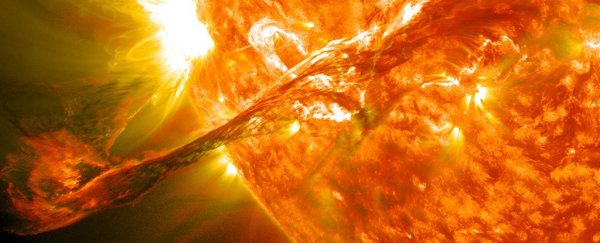It's a strange and lucky irony that the worst solar storm in recorded history happened at a time when human civilisation wasn't yet uniquely vulnerable to the Sun's inescapable geomagnetic fury.
The Carrington Event – aka the solar storm of 1859 – saw a huge solar coronal mass ejection unleashed at Earth's protective magnetosphere, producing an epic geomagnetic storm the scale of which modern civilisation had never before witnessed.
As a barrage of charged particles collided with Earth's magnetic field, intense auroras lit up skies around the world – but with strong electrical currents sweeping across the globe, the repercussions went far beyond colourful visuals.
Telegraph systems covering Europe and North America went down, as sparks flew from equipment, giving electric shocks to their human operators and even starting fires. Amid the electrified tumult, machines that had been disconnected from their power supplies eerily continued to relay their truncated messages.
It was, in other words, technological chaos. Yet from the comparatively futuristic perspective of 2018, as far as tech apocalypses go, it all sounds rather quaint and contained.
If a similar-scale solar storm were to strike Earth's pervasive technological systems right now – over a century and a half later – what would happen?
Nobody knows for sure how bad things would be, but given how scarily reliant we are on today's deep-rooted technological and electronic superstructures – compared to the primitive and relatively rare contraptions of 1859 – it would certainly be no picnic.
Perhaps our most relevant clue lies in some strange events that befell the world in the month of March, 1989.
Back then, a severe but not-Carrington-class solar storm struck Earth, courtesy of another coronal mass ejection from the Sun. Again, intense auroras resulted, leading some to think they could be seeing hazy after-effects of World War III.
Yet it wasn't a nuclear strike disrupting radio signals and satellite communication systems, but the flow of charged particles getting caught up in Earth's magnetic field lines.
The most extreme results were felt in Quebec, Canada, where the power grid went offline, meaning some 6 million people were immediately deprived of electricity. For many, the outage lasted only hours, but for others it took days for the power to come back on.
It's this kind of medieval scenario that has scientists at the White House worried a doomsday-scale geomagnetic storm on the level of the Carrington Event could effectively send the world back to the Dark Ages.
The thinking goes that "the big one", when it hits (about once every 500 years, if not sooner) would be powerful enough to knock out electrical and communications systems across Earth for days, months, or even years – nixing power grids, satellites, GPS, the internet, telephones, transportation systems, banking, you name it.
And forget taking out Quebec – we could be talking about all of Canada going offline, maybe the whole world – and with only hours of warning before technological darkness falls.
It sounds like something out of a disaster movie, but it's not the stuff of fiction. Conservative estimates suggest we could be looking at up to US$2 trillion of damage in the first year of such a calamity, with a recovery effort that could take a decade for the world to pull off.
On the more extreme side, others say US$20 trillion is a more reasonable figure – an inevitable damage bill that should perhaps make us reassess the risk factors of space-borne destruction.
"In terms of risk from the sky, most of the attention in the past was dedicated to asteroids," astrophysicist Abraham Loeb from Harvard University explained to Universe Today last year.
"But a century ago, there was not much technological infrastructure around, and technology is growing exponentially. Therefore, the damage is highly asymmetric between the past and future."
In a best-case scenario, a severe geomagnetic storm might only result in limited communications disruptions. But as history has shown, even such small-scale interference with the wrong kind of technological systems can have devastating consequences – like taking the world to the brink of nuclear war.
Just where a more powerful solar storm might take us next – or when – is the million-dollar question. Under majestic auroras, we might be forced to undergo a brutal, incalculable reset.
"An event of [Carrington] scale could be catastrophic if it happened tomorrow," director of research for MIT's Energy Initiative, Francis O'Sullivan, told CNET last week.
"It's not just the lights going off now. It's bank accounts disappearing… If you think what would happen if the stock exchange was taken offline for a week or month or if communications were down for a week or a month, you very quickly get to a point where this might be one of the most important threats the nation faces, bar none."
